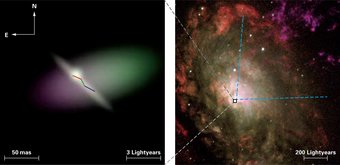The Dusty Heart of an Active Galaxy
An international research team with participation of MPIA obtained the most detailed view so far of the warm dust in the close environment of a supermassive black hole in the center of an active galaxy. The observations of the Circinus galaxy at a distance of 13 million light years show, for the first time, that the dust directly illuminated by the central engine of the active galaxy is located in two distinct components.

Central regions of active galaxies like the Circinus galaxy are emitting tremendous amounts of energy, because matter is heated up while falling into the super-massive black hole (with a mass of up to several billion solar masses).
Using the MIDI instrument at the Very Large Telescope Interferometer of the European Southern Observatory (ESO) in Chile, the research team obtained an unprecedented clear view of the warm dust in the nucleus of the Circinus galaxy. MIDI was built by seven institutes under the direction of MPIA. The high resolution is achieved by combining the light of two seperate telescopes (Interferometry).
The right image shows the inner 1000 light years of the Circinus galaxy. Blinding light and gaseous material are ejected by the active nucleus (located at the black box). They escape only along a conical region towards the northwest (upper right part of the image), leading to the white V-shaped structure. Along other directions, the nuclear region is hidden by dense gas and dust. This obscuring dust has now been investigated with unprecedented detail. The false-colour model image on the left shows the dust emission and corresponds to the region marked by the black box in the right image. The emission comes from a relatively thin, disk-like structure (white) and from an elongated structure perpendicular to the disk. The disk is also seen by water line-emission (red-green-blue line). The dust emission is more absorbed towards the southeast (bottom left) than the northwest (top right), illustrated by the change from violet to green colours.
MPIA co-author Klaus Meisenheimer says: "With the spatial resolution of one light year, we managed to see for the first time that the dust distribution inside an active galactic nucleus is far more complex than the much favoured model of an axis-symmetric dust donut or dust tire."
- ADS Entry for the research paper
- Detailed press release from the Max Planck Institute for Radio Astronomy
Images

